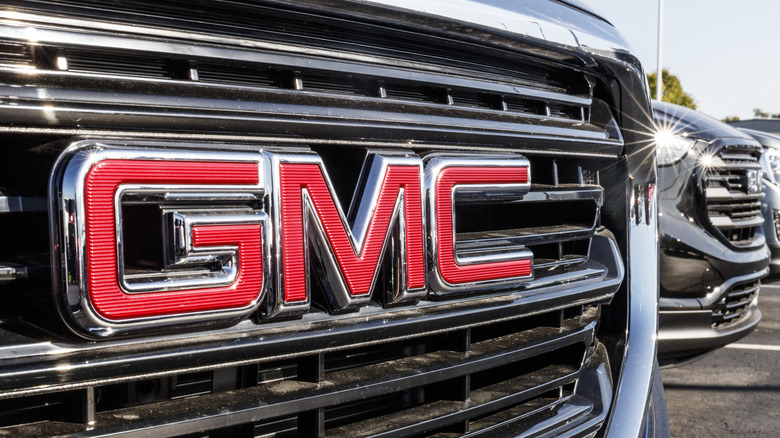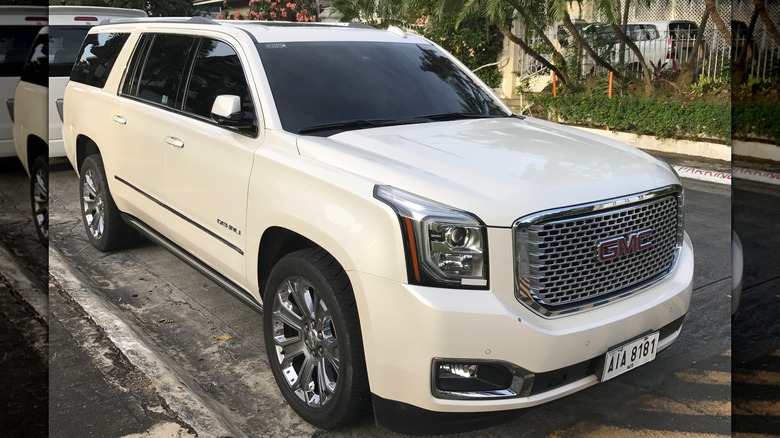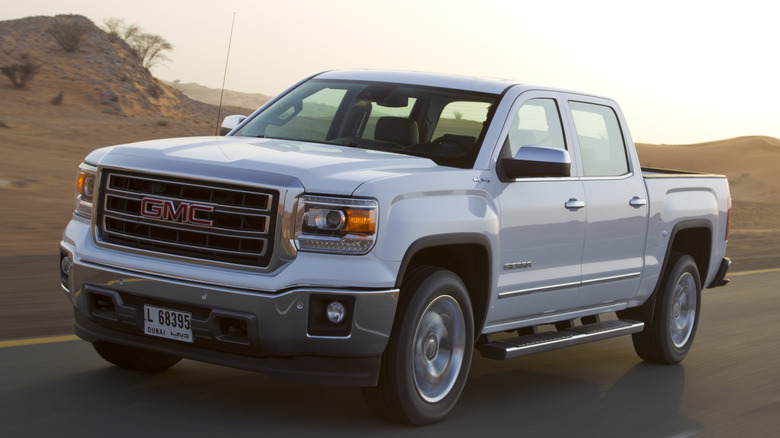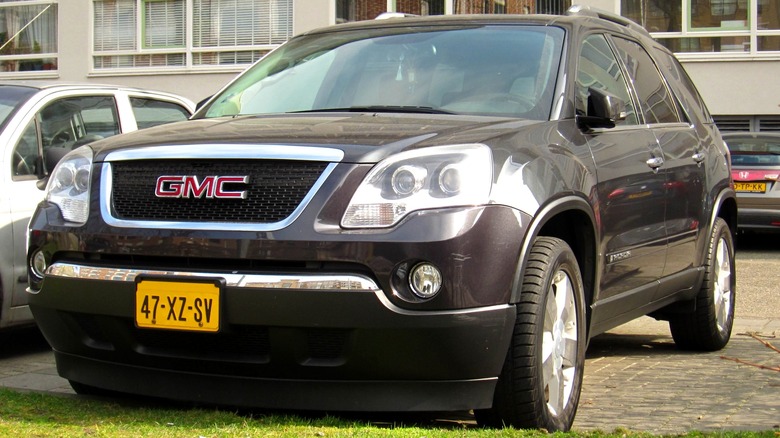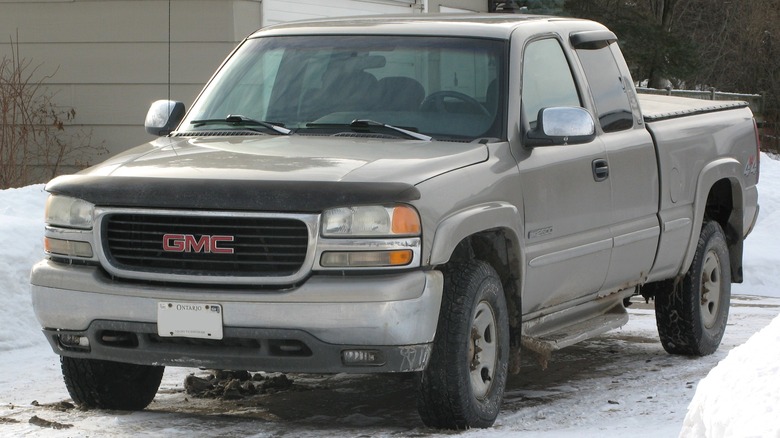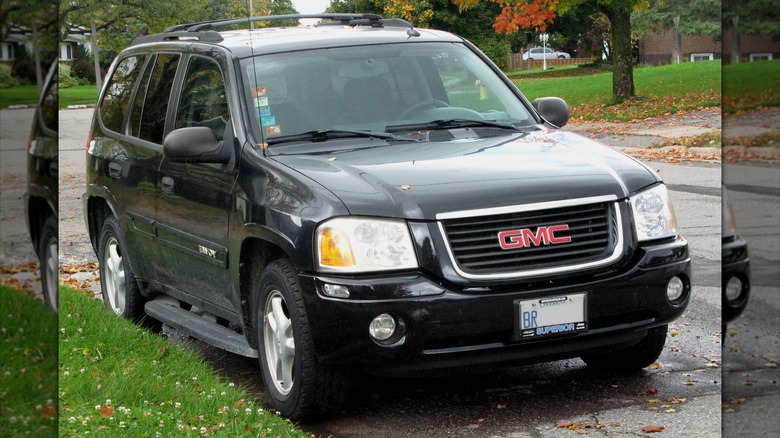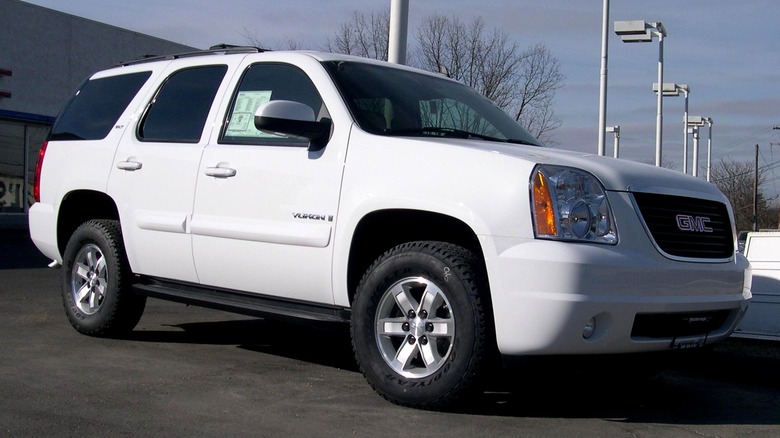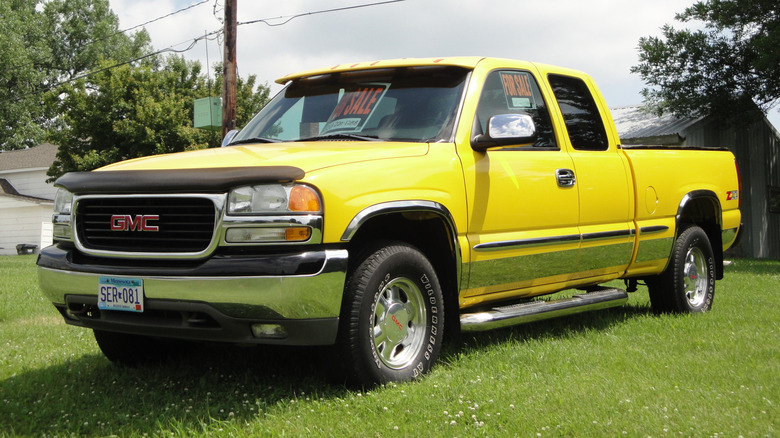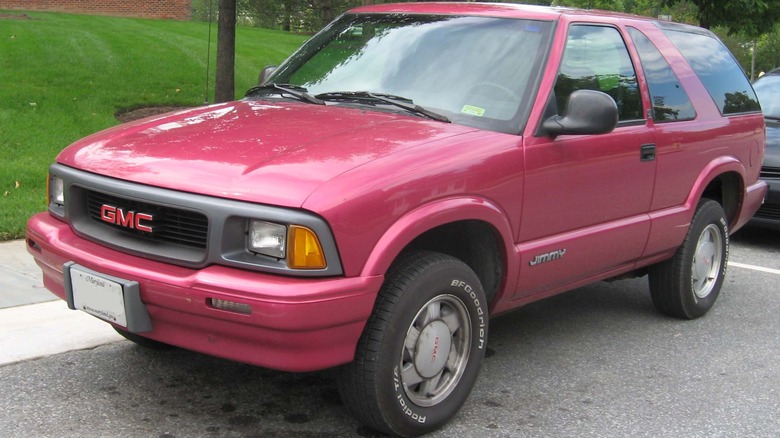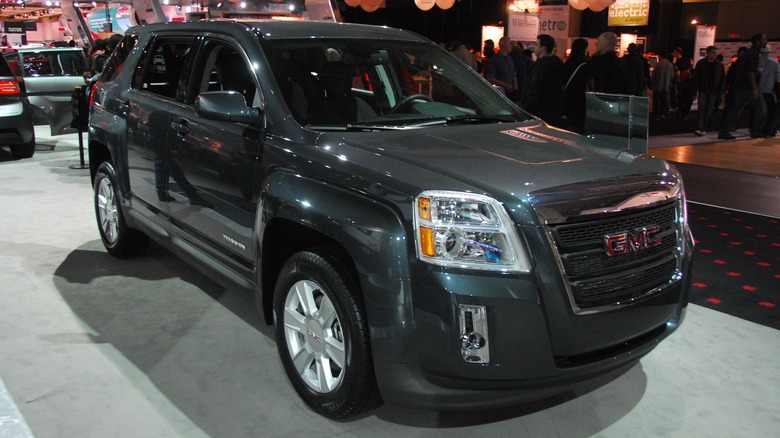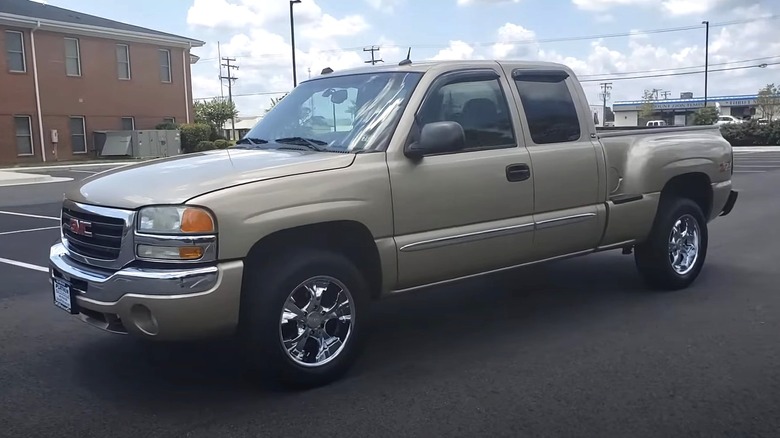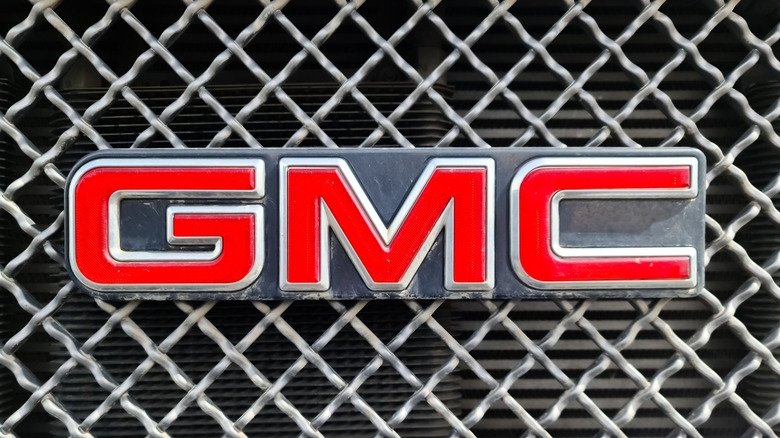10 Used GMC Models You Should Steer Clear Of At All Costs
In the world of trucks and SUVs, the GMC name carries a lot of weight — literally and figuratively. The company's roots go back to the beginning of the 20th century, when brothers Max and Morris Grabowsky founded the Grabowsky Motor Company in 1900. The Grabowsky Motor Company became the Rapid Motor Vehicle Company in 1902, and eventually came under the ownership of General Motors founder William Durant in 1909, who would merge it with the Reliance Motor Car Company to create the General Motors Truck Company — the GMC we know today.
Over the years, GMC has manufactured a huge range of trucks including the extremely long-lived Chevrolet/GMC Suburban and the GMC Sierra, the latter of which was one of the best-selling vehicles of 2023.
Despite their popularity, GMC vehicles have a slightly spotty history with reliability. GMCs performed above average in the 2022 and 2023 J.D. Power Vehicle Dependability Surveys but scored noticeably worse than the median in 2024 and 2021 — not a deal-breaker, but also a reason to keep your eyes open when shopping for a used GMC. So, to help you navigate the potential minefield that is the GMC back catalog, we've gone through NHTSA complaints to identify 10 used GMCs you should definitely avoid.
2015 GMC Yukon XL 1500
If you're looking for the largest full-size SUV you can buy, the Yukon XL — and its higher-end Denali version — will likely be near the top of your list. But with new prices mostly sitting north of $60,000, the idea of buying a used Yukon XL might seem like a good one, and it probably is. However, there's one model year in particular you should try and avoid: the 2015 Yukon XL.
Both the 2015 Yukon XL and Yukon Denali XL have some of the highest rates of complaints for GMC vehicles, at least based on the NHTSA website. The Yukon XL has 787 complaints, while the Denali XL has 922. The most common pain point for owners of the 2015 Yukon XL is the electrical system, which seems to exhibit a wide range of less-than-desirable behaviors. The more common problems include a faulty trailer brake connection that made the system consistently throw up errors, intermittent tail lights, iffy door locks, electrical fires, malfunctioning driver assist, and the occasional case where warning lights would randomly turn on and go haywire.
Mechanical issues were also present, with the transmission exhibiting problems like lurching, jerky movement, slipping gears, and inability to shift. The only solution seemed to be a new transmission. And, to top it all off, the power steering also seemingly stopped working randomly — quite a danger on a vehicle this huge.
2014 - 2015 GMC Sierra
GM unveiled the third-generation GMC Sierra in 2012, with the refreshed pickup making its way to owners in the 2014 model year. Journalists enjoyed the pickup when it debuted, particularly for its high-quality interior and quiet ride. But while early impressions were positive, long-term ownership would eventually highlight a range of problems that make these two years somewhat less ideal for anyone hoping to buy a trouble-free used pickup.
Owners posting to the NHTSA website have reported a wide range of electrical issues with the 2014 and 2015 Sierras. The trucks randomly turn off while driving. The battery drains overnight. There are problems with the computer-controlled electric power steering. Apparently the trailer braking system throws up warnings regularly. Some owners have even had electrical fires — often starting in the rear window defroster circuit. Some claim that the grounding schematic is inherently faulty, with corrosion eventually causing an intermittent connection that cuts power.
As with the 2015 Yukon, the 2014 and 2015 Sierras also have mechanical woes. The brakes are suspect, with owners attributing it to a failure-prone vacuum pump. The transmission isn't without problems, either, and quite a few owners note that it tends to shift rough and drop into neutral for no particular reason. Add in the NHTSA's "do not drive" advisory for the 2014 Sierra for a tie rod issue and it's probably safe to say you'll want to give these two GMC Sierra years a wide berth.
2007 GMC Acadia
The Acadia was a 2007 introduction to GMC's model line, with the seven-seater taking its place in history as GM's first-ever crossover SUV. It seemed like a good move at the time, too, with contemporary reviews praising — if not necessarily raving about — GMC's entry into the burgeoning market. Unfortunately, the years haven't been kind to the Acadia, with the NHTSA recording 853 complaints for the first-year model (curiously listed as a 2008 model).
Despite not being one of the GMC models affected by the Takata airbag issue, 2008 Acadia owners have had a lot of difficulties with the airbags, most notably with the airbags not deploying in the event of a frontal collision. The "service airbag" light also tends to come on when the Acadia hits a bump or when the passenger moves in the seat, with no clear indication — from the information we have access to, at least — whether this warning indicates an actual failure or if it's just some glitch in the wiring.
Unsurprisingly, the Acadia's electrics have also come in for criticism over the years. Issues such as battery drain, StabiliTrak failures, iffy power windows, and random power steering failures have all reared their ugly heads over the years. Add to that a dodgy, failure-prone transmission, and you have the recipe for a vehicle you're best off skipping over in the used car lot.
1999 GMC Sierra
The second-generation GMC Sierra pickup debuted in 1999 with many improvements over the previous model, including all-new V8 engines. These ranged from a 255-hp 4.3-liter engine all the way to a 6.0-liter unit making 300 hp and 355 lb-ft of torque, with owners having the choice of a four-speed automatic or five-speed manual transmission.
Magazines at the time also pointed out the new Sierra's improved braking and four-wheel ABS systems; these seemed like a good idea on paper, but the reality was somewhat different. Owner complaints cataloged on the NHTSA website show that the brakes are likely the worst part of the 1999 Sierra. Nearly half of the complaints involve the brakes in some fashion. ABS issues are present, but the most common complaint involves the brake pedal going straight to the floor when pressed. The main culprit seems to be the brake lines, which are prone to severe corrosion and eventual failure.
Rust and corrosion seem to affect more than just the brake lines, too. Owners also note other parts of the car are also rust-prone, such as the crossmembers and tailgate cables. One owner had their crossmember fall apart, and many others note that the undercarriages of their Sierras exhibited more rust than was common — possibly leading to some of the many rattles and suspension troubles owners also complain about.
2003 - 2005 GMC Envoy
Initially released in the late 1990s as a more premium version of the GMC Jimmy, the GMC Envoy was one of the many SUVs vying for attention in the mid-2000s. And while it wasn't necessarily loved back in the day, the 2003 Envoy's $33,000 MSRP meant that it was at least competitive with rivals from Lincoln, BMW, and Volkswagen.
Sadly, the affordable price seems to have impacted the SUV's reliability. 2003 to 2005 Envoys have many complaints on the NHTSA website, with the 2004 model having the most at 717. Issues seem quite consistent over all three model years, mostly pointing at the electrical system. But it wasn't just one problem: Owner grievances range from lights that turn on and off intermittently (including when the vehicle's off) to dodgy gauges, non-working third brake lights, and power window failures. More seriously, owners also reported electrical fires. The most common culprit seemed to be the driver's side window wiring.
Owners also had problems with their engines dying and stalling seemingly at random, with no real clarity as to whether these were mechanical or electrical faults — judging by the other electrical issues, we wouldn't be surprised if it was the latter. 2003 and 2005 Envoys also had a lot of fuel system complaints, usually involving inaccurate fuel level readings and leaky fuel tanks.
2007 GMC Yukon
The mid-2000s was not the best time for GMC, although as with many manufacturers, the true extent of the troubles would not become clear until much later. Yep, we're talking about the infamous Takata airbag recall saga, which came to light in the mid-2010s. GMC got away relatively scot-free compared to companies like Honda, although the 2007 Yukon was one of the models affected. But that's not actually why the 2007 Yukon is on this list.
The 2007 Yukon had way more issues than dangerous airbags — even if they are the main source of owner complaints on the NHTSA website. The airbag issues go hand-in-hand with problematic electrics, with owners complaining of everything from relatively innocuous quirks like glitchy instrument panels to much more dangerous electrical fires.
The 2007 Yukon's 5.3-liter V8 engine is also allegedly a troublesome unit, and more than a few owners noted that they had issues with oil starvation in the engine and lifter failures. We're not sure if there's a direct link between the two, but it seems likely. Other problems include throttle body failures, transmission failures, and a tendency for the car to lose power randomly. It's hard to say whether the latter has anything to do with the former problems, but the whole picture seems like a potential headache you're probably best staying away from.
2000 - 2003 GMC Sierra
GMC's Sierra has had many troublesome years, but the early 2000s models stick out from its siblings for the sheer number of recalls they've faced. The NHTSA website records more than 10 recalls each year for mundane issues like poor headlight visibility as well as more serious concerns like faulty wheel hubs and a fire hazard posed by leaky oil filters. Ideally, any 2000 to 2003 Sierra you're looking at will have had these problems looked at, but it's a pretty big list of potential faults you'll need to check out.
As far as owner complaints go, a huge proportion — just over 300 out of the 727 for the 2000 Sierra, for example — have to do with the brakes. Unsurprisingly, the main culprit is the brake lines, which tend to rust and burst, impacting the flow of brake fluid and reducing braking effectiveness severely. And the brake lines aren't the only issue: Some owners also report that the early 2000s Sierra's fuel lines can also rot out and fail, although it doesn't seem nearly as widespread as the braking problem.
As with the previous year's Sierra, the frame also tends to rot, although there are more reports of it with the 2000 Sierra in particular (although the next couple of years aren't too great either). The crossmember, main frame rails, and even rear spring perches all seem very rust-prone. Not an issue you want to deal with on a used truck.
1995 GMC Jimmy
GMC's Jimmy started life as an upmarket version the Chevolet Blazer in 1970 — one of the many Chevrolet and GMC crossovers. It's one of the many GM Square Body trucks that modern enthusiasts rate highly today, and it's not hard to see why. Retro-cool styling and great looks, coupled with the appeal of a 400 cubic inch V8 under the hood, make them serious collector items today.
However, the 1995 GMC Jimmy was a different beast. This compact SUV shared the smaller Chevy S-10 Blazer's platform. And while it may not quite have the cachet of the Square Body Jimmy, the years have been kind to the mid-'90s Jimmy, and its rounded look is now starting to feel cool all over again. Prices are good, too, with Kelley Blue Book naming a Fair Purchase Price of roughly $2,000.
Unfortunately, the 1995 Jimmy isn't without its problems. Owner complaints logged on the NHTSA website pinpoint a failure-prone ABS that locks up the front wheels as the main headache, with an unintended acceleration issue compounding the headache. The exhaust gas recirculation (EGR) valve also tends to get stuck and cause poor running. While these perhaps aren't the biggest deal-breakers ever, you'll be dealing with these alongside all the other woes of running a 30-year-old car; unless you're willing to deal with all of that, you're best avoiding the Jimmy.
2011 - 2013 GMC Terrain
GMC's early-2010s Terrain doesn't have nearly as many complaints as some of its stablemates, but we opted to include this over some other GMCs for a bit of variety — and to show that there's more to the brand's troubles than Yukons and Sierras. The first-gen Terrain was a 2011 vehicle and, at that point, the fourth offering that used GM's TE architecture, after the Saturn Vue, Cadillac SRX, and Chevrolet Equinox.
The major grievance from 2011 to 2013 Terrain owners have had is excessive oil consumption, which is present across all three years we're covering here. The oil consumption seems to have had knock-on effects for owners, too, with the NHTSA website also hosting a range of other engine issues that may have resulted from running the engine with low oil. These include timing chain failures, piston compression problems, and engine failure — sometimes requiring replacement engines outright.
Transmission problems seem to be a constant secondary threat to these early Terrains, too. While they don't seem as prevalent as engine woes — based on owner complaints, at least — there are more than enough instances of failed transmissions (often attributed to the transfer case) to cause concern. The situation isn't too dissimilar to the bad years of the Chevrolet Equinox.
2004 GMC Sierra
GMC doesn't seem to have had that great a time with the Sierra around the turn of the millennium. The 1999 to 2003 Sierras all had issues with corrosion on the frame and the brake lines, which invariably resulted in brake failures for owners. The 2004 Sierra seems to have improved the situation ever so slightly on that front, but, as with so many things in life, it was a case of one step forward, one step back.
Rusted and ruptured brake lines are still problems with the 2004 Sierra, according to complaints recorded by the NHTSA. However, unlike previous years, the brakes don't seem to be the most troublesome area of the truck anymore. Instead, the 2004 GMC Sierra seems to have ushered in the era of electrical woes that carried on for a few more years after this in many GMC vehicles.
The primary problem with the 2004 Sierra's electrics seems to be the instrument panel and gauges. The instrument panel stops working intermittently, while gauges such as the speedometer and fuel gauge either stop working or misreport. Other electrics like motorized side mirrors, powered seats, and radio can also go wrong, with some owners reporting these devices going haywire randomly. While not all of these directly affect drivability, we feel they're headaches you're better off sidestepping — especially when you remember you'll be buying a 20-year-old truck with other age-related issues on top of that.
Methodology
The primary source for this list is the NHTSA website, which catalogs owner complaints, recalls, investigations, and manufacturer communications about cars sold in the U.S. More specifically, we focused on owner complaints, selecting GMC models based mostly on how many the NHTSA logged. This isn't a perfect indicator of reliability, but it's a great starting point that can help highlight some of the most problematic cars. However, numbers alone don't tell the full story and our list also considers the nature of the faults. After all, rattly interiors and loose sun visors aren't nearly as troubling as corrosion-prone brake lines and electrical fires.
Manufacturer recalls also played a part in our recommendations, as these can also help highlight any severe issues. Ideally, any used car you buy should have been looked at and fixed under a recall, but there's always the risk that a previous owner overlooked it. Or, even worse, that the issue is one of the many that recurs even after a recall fix. This isn't to say that a model year with severe recalls is automatically one to avoid, but it's certainly one that you would do well to check thoroughly before even considering a purchase.
